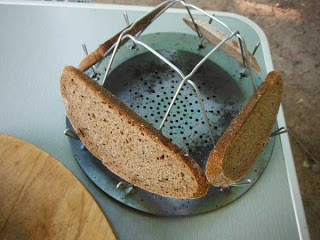Last bread baked at home before holidays:
25% rye, 75% ww loaf
This 80% hydrated bread has 5% wheat germ, and is made with sourdough starter. The oven temperature was different: I kept it at 500 degrees for the first 15 minutes, then backed it off to 425 degrees. After 5 minutes at this lower temperature, I pulled the lids off the dutch ovens, and continued baking for 20 more minutes.
The dough was mixed late at night, and stretched/turned 3 times after adding the salt before I placed it in the refrigerator. It was brought out of the fridge in the morning, and allowed to sit only 30 minutes before another stretch/turn -- the dough was still cool to touch. After a second stretch/turn, it was divided and placed in bannetons to rise. Total proofing time once it hit the basket was 2 hours and 20 minutes.
Curious Fact about Rye
I've been dipping into Sandor Katz's new book, "The Art of Fermentation: An In-Depth Exploration of Essential Concepts and Processes from Around the World," and I highly recommend it -- but then, I also loved his earlier book, "Wild Fermentation." The books do have some overlap, but in the newer book, Katz goes even deeper into varied techniques.
Discussing how humans and plants have "co-evolved with bacterial symbionts," Katz gives the following fact about rye plants that is sure to awe:
"Roots and their surfaces for soil interaction are actually far more elaborate than meets the eye. A single rye plant, growing but a season, has millions of rootlets, altogether running an estimated 680 miles/ 1,094 km, and each of the rootlets is covered with still smaller root hairs, numbering in the billions on each plant, altogether running 6,600 miles / 10,600 km. All these microscopic hairs release exudates into the soil, highly regulated excretions including sugars, amino acids, enzymes, and many other nutrients and unique chemical compounds, creating a very selective environment in which they 'literally call the proper bacteria to the area where [the plant] is growing…"
This simply reminds me of the facts we learn in anatomy, when we take up the topic of the human gut: how the intestinal folds are coated with villi, which are in turn composed of microvilli -- all designed to increase the surface area of the gut membranes, to allow passage of more nutrients from digested food. The villi and microvilli together increase the surface area of the gut to about 100 times the surface area of the entire body's skin surface.
I'd like to learn a lot more about the human gut, and especially how it digests grains. I have heard it suggested that some parts of some grains will somehow join with the villi and microvilli and allow passage of some rather unexpectedly large molecules into the lymph and bloodstream -- perhaps through enlarged ion channels.
There are a lot of mysteries in the human gut, and obviously a lot of mysteries in the soil beneath our feet in the fields where grains are grown.
This loaf
was excellent. I took both loaves with me when I went camping, and didn't require any other bread for several days.
Notes to Myself
- Research more on the gut and how grains are digested. What molecules are involved? How is grain broken apart by the body's enzymes? Get into some specifics about how the parts of grain embed themselves in the microvilli -- if indeed this is true. How would you find out? Does it occur in all people, or just in the ones who can't tolerate gluten? What molecules pass through the brush border of the gut? What molecules don't?
- Become more knowledgeable about the sizes of the microscopic world around you. Become familiar with the sizes of molecules and cells.









No comments:
Post a Comment